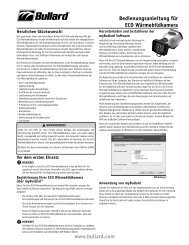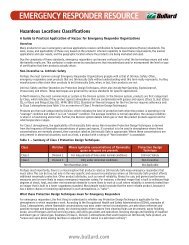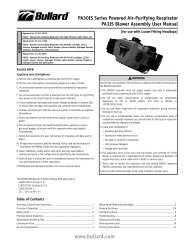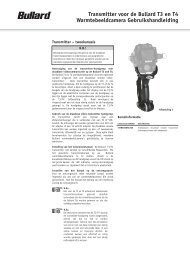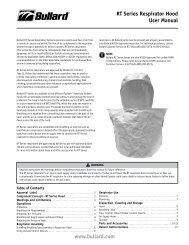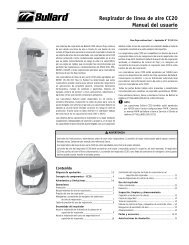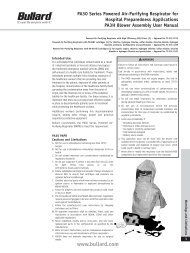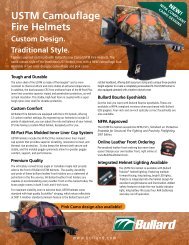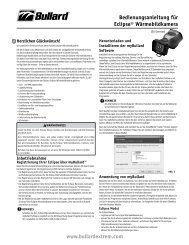Instruction Manual - Bullard
Instruction Manual - Bullard
Instruction Manual - Bullard
Create successful ePaper yourself
Turn your PDF publications into a flip-book with our unique Google optimized e-Paper software.
For use with 88VX, CC20, RT and<br />
GR50 Airline Respirators<br />
Includes: AC1000 Cool Tube, belt bracket, nylon belt and heat shield.<br />
Function: The AC1000 is NIOSH approved to supply a continuous flow<br />
of cool air to <strong>Bullard</strong> 88VX, CC20, RT and GR50 Series airline respirators.<br />
All <strong>Bullard</strong> parts must be present and properly assembled to constitute<br />
a NIOSH approved respirator.<br />
NOTE<br />
AC1000 cannot be used with a low<br />
pressure air source such as an<br />
ambient air pump.<br />
WARNING<br />
Before using this product, read and follow all<br />
directions and warnings, including those in<br />
the respirator instruction manual. Failure to<br />
follow these instructions could result in death<br />
or serious injury.<br />
WARNING<br />
This climate control system is not recommended for cooling the<br />
air supply when the air temperature is less than 70°F. Since<br />
the system may cool the incoming air by more than 30°F, it is<br />
possible for ice to form in the breathing tube and reduce the<br />
airflow. Failure to observe this warning could result in death<br />
or serious injury.<br />
Air Quality Requirements<br />
Respirable air must be supplied to the point-of-attachment of the NIOSH<br />
APPROVED BULLARD air supply hose. The point-of-attachment is where<br />
the air supply hose connects to the fitting that contains a pressure<br />
gauge used to monitor the pressure of the air provided to you.<br />
Locate the source of supplied air in a clean environment far enough<br />
from your work site to ensure the air remains contaminant-free. Always<br />
use an inlet filter on your air source and any monitors and alarms as<br />
necessary to assure clean, breathable air at all times.<br />
Supplied breathing air MUST meet or exceed the requirements for Type<br />
1 gaseous air described in the Compressed Gas Association Commodity<br />
Specification G-7.1 (Grade D or higher quality) as specified by Federal<br />
Law 42 CFR, Part 84, Subpart J, 84.141(b) and 29 CFR 1910.134(i)(1)(ii).<br />
The requirements for Grade D breathable air include:<br />
Oxygen .......................................................................................... 19.5-23.5%<br />
Hydrocarbons in mg/m3 of gas ............................................ 5 mg/m3 max.<br />
Carbon monoxide ......................................................................10 ppm max.<br />
Carbon dioxide.....................................................................1,000 ppm max.<br />
Odor .......................................................................... No pronounced odor*<br />
No toxic contaminants at levels that make air unsafe to breathe.<br />
* Specific measurement of odor in gases is impractical. Air normally<br />
may have a slight odor. The presence of a prolonged odor should<br />
render the air unsatisfactory.<br />
Refer to C.G.A. Commodity Specification G-7.1 for complete details,<br />
or contact the Compressed Gas Association (1235 Jefferson Davis<br />
Highway, Arlington, VA 22202 or www.cganet.com).<br />
www.bullard.com<br />
AC1000 Cool Climate Control Tube<br />
User <strong>Manual</strong><br />
Air Pressure<br />
Belt Bracket<br />
WARNING<br />
Quick-Disconnect<br />
Nipple<br />
Air Temperature<br />
Control Knob<br />
The respirator’s air source must supply clean, breathable air,<br />
Grade D or better, at all times. The respirator does not purify air<br />
or filter out contaminants.<br />
Connecting the respirator to a line supplying nitrogen or other<br />
harmful gases could cause death or serious injury.<br />
Failure to follow these instructions could result in death or<br />
serious injury.<br />
Continually monitor the air pressure at the point-of-attachment while<br />
operating the respirator. A reliable air pressure gauge must be present<br />
to monitor the pressure.<br />
WARNING<br />
Failure to supply the minimum required pressure at the pointof-attachment<br />
for your hose length will reduce airflow and<br />
could result in death or serious injury.<br />
It is important to operate the <strong>Bullard</strong> climate control device in the<br />
prescribed pressure range for the particular <strong>Bullard</strong> respirator you<br />
are using. Operating the correct pressure range will insure that the<br />
correct air flow is delivered to the respirator and will maintain the<br />
NIOSH approval. Refer to your respirator user manuals’ Breathing Air<br />
Pressure Table to determine the correct pressure that should be used<br />
with the climate control device. This table defines the pressure ranges<br />
necessary to provide the respirator with a volume of Grade D air that<br />
falls within the U..S. Government required range of 6-15 cfm (or 170-<br />
425 lpm). (See 42 CFR, Part 84, Subpart J, 84.150)<br />
The Breathing Air Pressure Table defines the air pressure ranges<br />
necessary to provide the 88VX, CC20, RT or GR50 Series respirator<br />
with a volume of air that falls within the required range of 6-15 cubic<br />
feet per minute (cfm) or 170-425 liters per minute (lpm).<br />
Be sure you understand the information in the BREATHING AIR<br />
PRESSURE TABLE before using the respirator. To use the table, follow<br />
the steps identified below:<br />
1. Confirm the air source and climate control device .<br />
2. Confirm your choice of NIOSH approved <strong>Bullard</strong> air supply hose(s) to<br />
use with your Cool Tube.<br />
3. Determine that your air supply hose does not exceed the maximum<br />
approved hose length or number of hose sections.<br />
4. Set the air pressure at the point-of-attachment within the required<br />
pressure range for your air supply hose length.
Air Supply Hose<br />
To maintain your <strong>Bullard</strong> respirator’s MSHA/NIOSH approval, use only approved <strong>Bullard</strong> V10<br />
Series hose(s) in lengths of 25 to 300 feet, or <strong>Bullard</strong> V5 Series hose in lengths of 25 or 50 feet,<br />
between the AC1000’s quick-disconnect fitting and the point-of-attachment to the hose. <strong>Bullard</strong><br />
V11 hose-to-hose adaptors MUST be used to connect V10 hose lengths together. Secure<br />
connection(s) until wrench tight and leak free.<br />
WARNING<br />
Use of any other air supply hose voids NIOSH approval on the entire respirator<br />
assembly and could reduce the airflow to the respirator. Failure to observe this<br />
warning could result in death or serious injury.<br />
Preparation and Use of the AC1000<br />
1. In an uncontaminated atmosphere screw the hose connector fitting on the end<br />
of the breathing tube to the fitting on the AC1000. Tighten hose connectors firmly<br />
(Figure 1).<br />
2. Lace the belt supplied with<br />
the Cool Tube through the belt<br />
bracket. Slots are provided<br />
for wearing the tube either<br />
vertically or horizontally on<br />
the waist. See Heat Shield<br />
instructions.<br />
3. With the approved <strong>Bullard</strong><br />
air supply hose connected to<br />
the air source and with air<br />
flowing into the hose, connect<br />
the quick-disconnect coupler<br />
on the air supply hose to the quick-disconnect nipple on the AC1000 Cool Tube.<br />
4. Adjust the air pressure at the point-of-attachment to within the approved pressure range<br />
(Figure 2). See the Air Pressure section on the front page.<br />
5. Don the respirator by following the directions in your respirator instruction manual. If you do<br />
not have instructions, contact <strong>Bullard</strong> Customer Service at the address or phone numbers<br />
given below.<br />
6. To obtain cooler air, turn the air temperature control knob counterclockwise (Figure 1).<br />
Maximum cooling is attained when knob is fully open and when there is maximum airflow<br />
out of the AC1000 exhaust port.<br />
To obtain air that is closer to ambient temperature, turn air temperature control knob<br />
clockwise. If knob is fully closed, your respirator will receive air at ambient temperature.<br />
7. When finished working, leave the work area wearing the respirator. With the air still flowing<br />
into the hood, remove the hood and then disconnect the air supply hose using the quickdisconnect<br />
coupler attached to the AC1000 Cool Tube.<br />
Figure 2<br />
Air supply hose<br />
<strong>Bullard</strong><br />
1898 Safety Way<br />
Cynthiana, KY 41031-9303<br />
Toll free: 877-BULLARD (285-5273)<br />
Tel: 859-234-6616<br />
Fax: 859-234-8987<br />
www.bullard.com<br />
Point-ofattachment<br />
Quick-Disconnect<br />
Nipple<br />
Breathing Tube<br />
Air Supply Hose<br />
Quick-Disconnect<br />
Coupler<br />
Belt Bracket<br />
Pressure gauge<br />
Grade D<br />
breathable air<br />
source<br />
<strong>Bullard</strong> GmbH<br />
Lilienthalstrasse 12<br />
53424 Remagen<br />
Germany<br />
phone: 0049-2642 999980<br />
fax : 0049-2642 9999829<br />
www.bullardextrem.com<br />
Air Temperature<br />
Control Knob<br />
Figure 1<br />
AC1000 Cool Climate Control Tube<br />
User <strong>Manual</strong><br />
Heat Shield <strong>Instruction</strong>s<br />
The climate control heat shield is designed to work with the <strong>Bullard</strong> AC1000, HC2400, or<br />
ACL99 climate control devices.<br />
Assembly<br />
The heat shield is designed to work with the standard nylon belt (part # 4612) supplied<br />
with the climate control devices.<br />
1. Determine whether the climate control device will be worn vertically or horizontally on<br />
the waist.<br />
2. If the device will be worn in the horizontal position, align the tube on the heat shield as<br />
shown in Figure 3. If the tube will be worn in the vertical position, align the tube on the<br />
heat shield as shown in Figure 4.<br />
3. Lace the belt supplied with your climate control device through both the heat shield slots<br />
and the climate control belt bracket slots.<br />
4. Use plastic zip tie to secure the climate control unit to the heat shield.<br />
Figure 4<br />
<strong>Bullard</strong> Asia Pacific Pte. Ltd.<br />
LHK Building<br />
701, Sims Drive, #04-03<br />
Singapore 387383<br />
Tel: (65) 6745-0556<br />
Fax: (65) 6745-5176<br />
www.bullard.com<br />
©2010 <strong>Bullard</strong>. All rights reserved.<br />
Figure 3<br />
ISO 9001<br />
certified<br />
6088001035F (0510)



